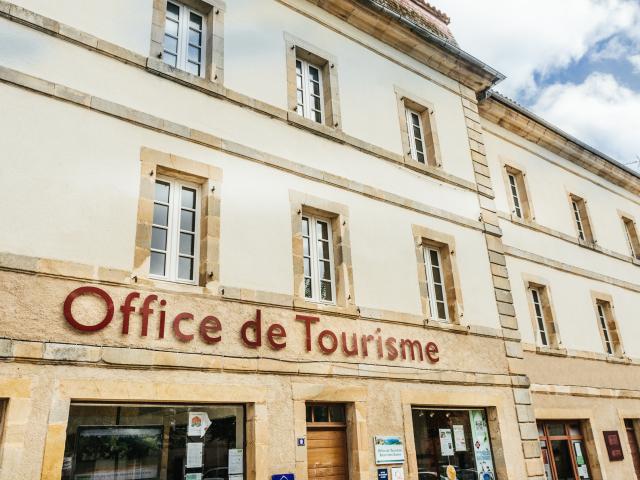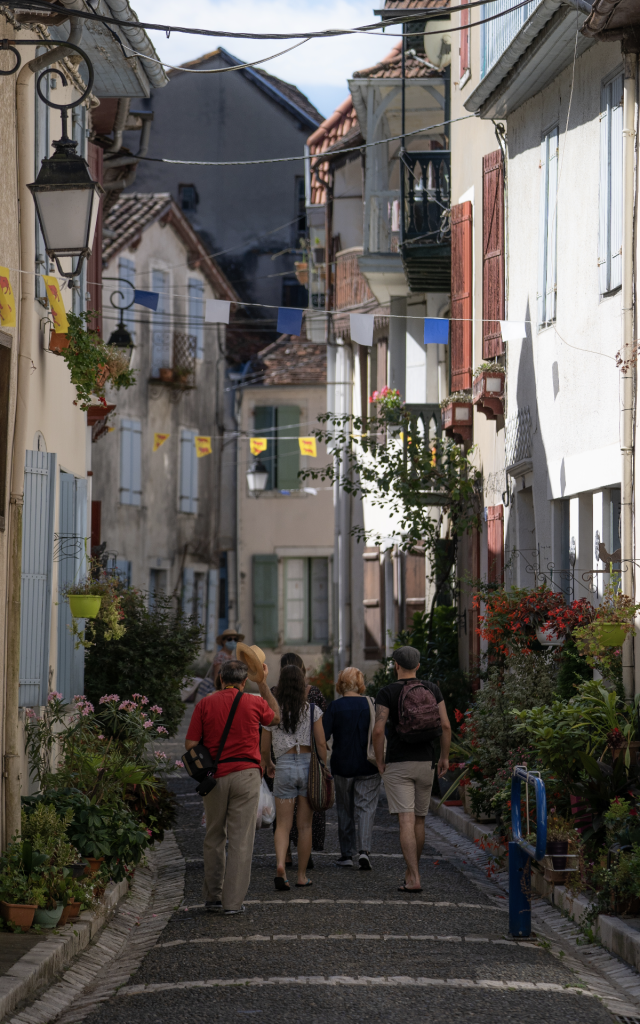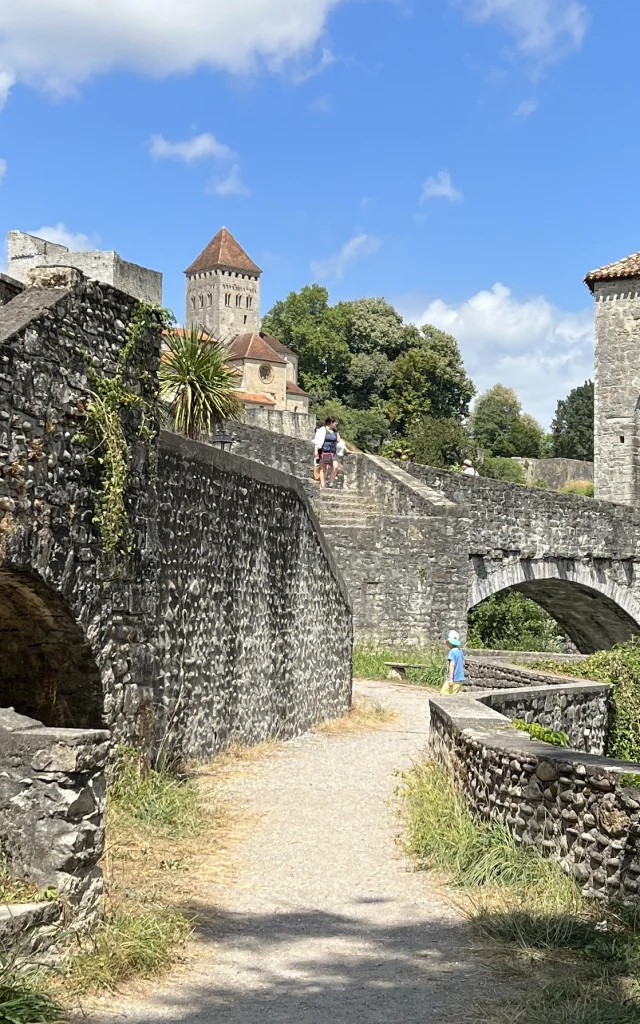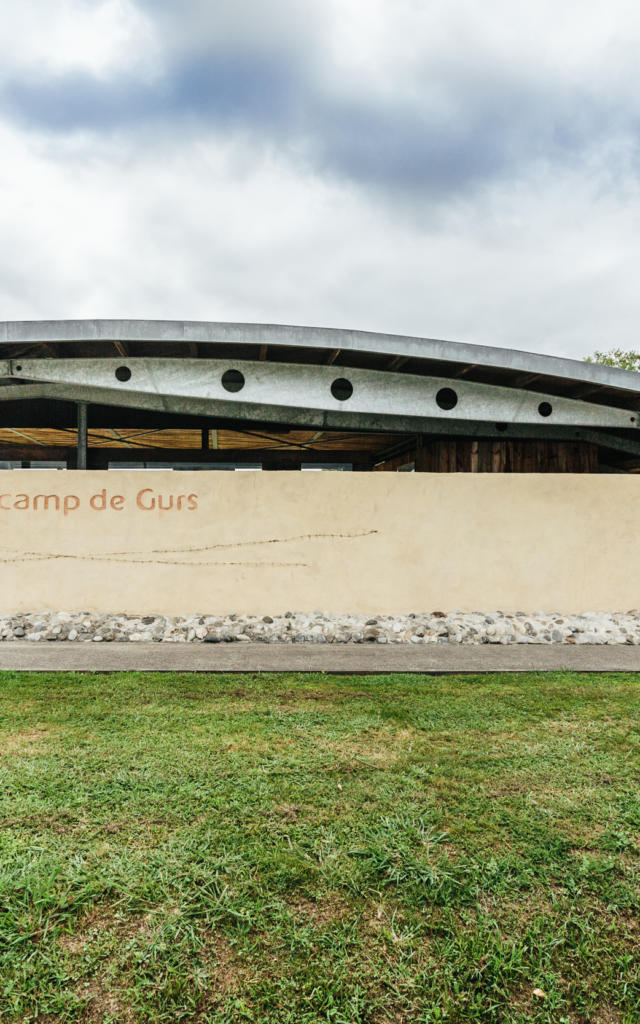 Sur les remparts de Navarrenx
Sur les remparts de Navarrenx0. Office de tourisme de Navarrenx
Read the description
Welcome to the heart of the Béarn. I am Fabricio Siciliano, architect of the ramparts in this town, with the Gave d’Oloron below and the imposing Pyrenees opposite. One of the oldest towns in the Béarn, this medieval burgh has preserved many of its ancient and historic features, and has also been designated one of the most beautiful villages in France.
Listen to the description
 Office de tourisme à Navarrenx
Office de tourisme à Navarrenx1. La Place des Casernes
Read the description
Here we are on the barracks square. The construction of the ramparts in the 16th century turned Navarrenx into a military stronghold. Barracks were built to house the garrisons of soldiers who would defend the fortified city. Two barracks were positioned on either side of the Porte Saint-Antoine. Initially, they could house 344 men, but when a regiment was passing through, up to 2,000 could be accommodated. The extra men were housed in the homes of local residents, who were required to take them in. This led to conflict, especially when the cost of feeding soldiers and horses wasn’t repaid for six or even twelve months.
In 1659, the Treaty of the Pyrenees was signed, putting an end to hostilities between France and Spain. Navarrenx lost its role as stronghold to the town of Saint-Jean-Pied-de-Port, in the Basque country near the Spanish border. From then on, only a garrison of soldiers remained in the town.
To the right of the main arcade, you can see a building that has been partially restored – the military prison. It comprises three cells, a small courtyard and latrines. The lintel of the doors bears the prison’s date of construction: 1750.
Let’s carry on towards the Porte Saint-Antoine, passing under the arcade and porch.
Listen to the description
2. La porte Saint-Antoine
Read the description
Here we are, at the Porte Saint-Antoine, also known as the Porte d’Espagne because it looks towards Spain. The gate’s strategic location is protected by an orillon, where the ramparts are shaped to shield the gate from direct fire.
The Saint Antoine Gate dates back to the construction of the ramparts. In the old days, there was also a drawbridge defending the gate. You can see the chain slots beside the gate. Facing you are the city’s famous ramparts.
Let me take you back to the 16th century, when the Béarn became part of the kingdom of Navarre, headed by the d’Albret family.
At that time, war was raging and the kingdom of Navarre had lost half its territory in Spain. Henri II of Navarre, Henri IV‘s grandfather, planned to take back Navarre from the kingdoms of Spain and France. He chose Navarrenx as the site for a place of safety, benefiting from all the latest advances in military defence technology of the time. I, Fabricio Siciliano, the talented Italian military engineer, began work on making Navarrenx a bastioned city in 1538. Yes, it was me, not Vauban! The fortifications you can see in Bayonne and Saint-Jean-Pied-de-Port were indeed built by Vauban, but he drew inspiration from my Italian architecture to create his own designs, adding improvements to my original model.
I designed the bastioned city in the shape of a tortoise. At the Tourist Office, you can find a model of the town and see the turtle for yourself. The ramparts go all the way round the city, covering a distance of 1.7km. They are 10m high and 4.50 m thick. It took around ten years to build these ramparts.
To reach the terrace above the ramparts and admire the landscape around you, go back to the Place des Casernes and take the steps on your left.
Listen to the description
3. La Terrasse
Read the description
Here we are, above the Porte de Saint-Antoine. From this terrace, you can admire the Gave d’Oloron, which is famous for its salmon. So famous, in fact, it is known as the Capital of Salmon. The Gave d’Oloron is a 1st category river upstream of the Castagnède bridge. Salmon has always been an important resource for the fortified city. For many years, Navarrenx supplied fresh salmon not only to the royal and wealthy tables of the Béarn, but also those of our Spanish neighbours. Salmon is an anadromous migratory fish, i.e. a sea fish that swims up the Gave to spawn. This attracts fishing enthusiasts who try to catch the “king fish”.
On your left, on the parapet walk, you can see a tower called a bartizan. It was used to keep watch over large areas, and especially the bridge across the Gave.
Listen to the description
4. Bastion de la clochette
Read the description
Here we are at the Bastion de la Clochette, protecting the Porte Saint-Antoine. The name of this bastion comes from the bell that was originally located here. It had two purposes: the first was to warn of an attack on the bastioned city, and the second was to alert fire fighters in the event of a fire. Fires were common in medieval times.
Looking at the landscape below the ramparts, you’ll see two statues. They represent pilgrims on their way to Santiago de Compostela. Once you’re on the Route du Puy-en-Velay, there are just 2 more stages before you meet up at Saint-Jean-Pied-de-Port in the Basque country, and then continue on to the famous crossing of the Pyrenees! Some 15,000 pilgrims pass through Navarrenx every year. There are gîtes and bed and breakfasts where pilgrims can rest and get a fresh start for the rest of their adventures.
You’ll notice a cannon on this bastion. It is not original. In fact, nothing is left of this stronghold’s extensive weaponry. However, on the barrel of the cannon you can see the coat of arms of the Béarn and the town’s motto in Béarnais: ‘Si you ti baü’. It means, “If I go…!”, a reference to the town’s fighting past.
To fire cannons, you need gunpowder, and a building to store it in. It’s just behind you – you can go inside.
Listen to the description
5. La Poudrière
Read the description
So here we are in the Poudrière, the one and only gunpowder magazine on the square. It was built in 1580 to free up the side aisles of the church of Saint Germain, which until then had been used for storage. Originally, there was a protective outer wall 3.55m high and 30cm thick, standing 3 metres from the building. The powder magazine could hold up to 25,000 pounds of powder, around 12 tonnes of explosives. If you look at the colour of the stone, you can see that it has been recently restored. In 1890, the building was converted into a reservoir for non-drinking water by raising the walls and installing a cistern. It was then restored in 1998 following to the original plans.
Do take a look inside, where you’ll find a small exhibition explaining the history of gunpowder.
If there are two or more of you, we recommend you stand in two diagonally opposite corners facing the wall. Go on, try whispering a few words and see what you hear!
Now take the rue Saint-Antoine to reach your next stop, Jeanne d’Albret’s House.
Listen to the description
6. Jeanne d’Albret’s house
Read the description
Here we are in front of the building known as Jeanne d’Albret’s house. Henri IV’s mother had a house in each town but she did not live there. There is also a house in Navarrenx destined for the Kings of Navarre.
This house dates from the 14th century. It has a Renaissance basket-handle door surmounted by a small triangular pediment. In 1555, Jeanne d’Albret became sovereign of Navarre and the Bearn. She adopted the Calvinist religion and brought Béarn into the small group of Protestant states.
Behind us is the town hall. The market hall stood on the site of the present-day town hall, and this is where the market was held. Nowadays, the market takes place every Wednesday morning just next door in the square in front of the church. So let’s go there now.
Listen to the description
7. The Church of Saint Germain
Read the description
Here we are at the church of Saint Germain. This church was built after the ramparts were finished, between 1550 and 1560. It replaced an earlier church of the same name belonging to the bastide which was demolished because it was too close to the walls. Jeanne d’Albret converted Saint Germain into a Protestant church when she recognised Calvinism as the official religion. In 1620, Louis XIII re-established Catholic worship in the Béarn and attended the first mass held here.
To the sides of the church, you can see large areas used to store gunpowder and ammunition before the powder magazine was built.
If you look up, you can see the church’s bell tower. In 1728, the Bishop of Oloron ordered the construction of a porch bell tower to replace the existing bell gable. He was able to do this because its low height meant it could not be used as a target.
Let’s go inside the church, as the interior is well worth a visit. It is a Gothic-style church. As you walk around the church, you can see sculpted heads on the pillars, some of which represent pilgrims on the way to Santiago de Compostela. At the entrance, you can admire copies of 3 paintings by Murillo, Dubois and Carracci donated by Napoleon III in the 19th century. Napoleon III’s wife, the Empress Eugenie, was ill and came to Navarrenx, whose mayor was a famous doctor, Dr Larralde. To thank him, Napoleon III presented these three paintings to the town.
At the side of the church is the Porte des Cagots, which was restored in 1873. The origins of the Cagots are not well known. In medieval times, the Cagots lived on the fringes of society. They were believed to carry all sorts of illnesses including the plague, and lived outside the town, where a special area was set aside for them. During church ceremonies, they had to enter by a separate door and had their own font which you can still see in the middle of the church. Originally, this door was smaller and the Cagots had to bend down in a show of submission to the other inhabitants of the town in order to enter the church.
On leaving the church, head up the Rue des Echos to reach the Bastion des Contre-mines.
Listen to the description
8. Bastion des Contre-mines
Read the description
Here we are at the Counter-mines bastion. This is the most elaborate bastion in the city. It has two faces and two receding flanks, protected by an orillon. This device allows you to listen in to see if the enemy is trying to reach the bastion by mining underneath it.
If you go down the steps, you can see a passageway leading down inside the walls and around the inside of the bottom of the bastion. We advise visiting the underground passages equipped with a torch and in good weather as it can get very slippy.
Once you have explored the dark underground passages, continue along the walkway to reach the Bastion of Echoes.
Listen to the description
9. Le Bastion des Échos
Read the description
Here we are at the Bastion known as ‘Les Echos’ or ‘Mont Livet’. This is an example of a primitive fortification with no orillons or receding flanks. However, like the Counter-Mine Bastion, it has an underground passageway that could be used as a secret escape route if there was an enemy attack. Under the arcades, there are slits like arrow holes in the walls that repeat the echo 7 times.
It feels like an open-air theatre!
In fact, the site was developed by a non-profit-making organisation called ‘Pierre et vestiges’, whose mission is to promote the heritage of the bastioned city.
Both the Contre-mines bastion and this one were overgrown. The charity cleared these two areas and used the stones on the ground to build the theatre and make real use of this space within the ramparts. Thanks to their efforts, shows now take place here. For example, every Tuesday during the summer there are cultural events, known as Mardis Musicaux.
To get to the military fountain, continue along the Rue des Echos and turn left after the Taverne Saint-Jacques.
Listen to the description
10. The Military fountain
Read the description
We’re now at the military fountain. We don’t know if the fountain existed before the ramparts were built. A rather vague plan of the bastide, dating from 1526, mentions several gates, one of which is called the ‘hount’, in other words the fountain. It is specifically mentioned in the journal of the siege of 1569.
In 1569, French troops laid siege to Navarrenx for 70 days in order to conquer the Béarn. However, the garrison of soldiers left Navarrenx had nothing to fear from the siege, thanks to the fountain that runs right through the heart of the fortified town. The attackers failed to find the source of the fountain and poison it.
Thanks to this resource, the French troops lost against the bastioned city and it is from this story that the name of this fountain comes.
In 1952, the fountain was filled in due to a typhoid epidemic. In 1989, it was reopened and restored.
To get to the last monument on the tour, take the Rue de la Fontaine, which leads to the town’s main shopping street, Rue Saint-Germain. Head along this street, with its many amusing shop signs, then turn left to enter the next building: the Arsenal.
Listen to the description
11. The Arsenal
Read the description
Here we are at the Arsenal. This imposing building is the former residence of the Kings of Navarre. In 1680, the building was radically altered to become the Arsenal, a store for weapons, munitions and supplies. A solid, imposing building with two storeys and an attic, it shows the importance of Navarrenx at that time. In the courtyard, 30,000 cannonballs and grenades could be stored, and under the arches, 60 cannon and mortar carriages and 150,000 bullets.
The house opposite is known as the King’s Lieutenant’s House. This is a private house rented by the King’s Lieutenant in 1724. It has all the hallmarks of 17th-century military architecture.
That’s the end of the walk, and I hope you’ve enjoyed travelling back in time in the bastioned city.









